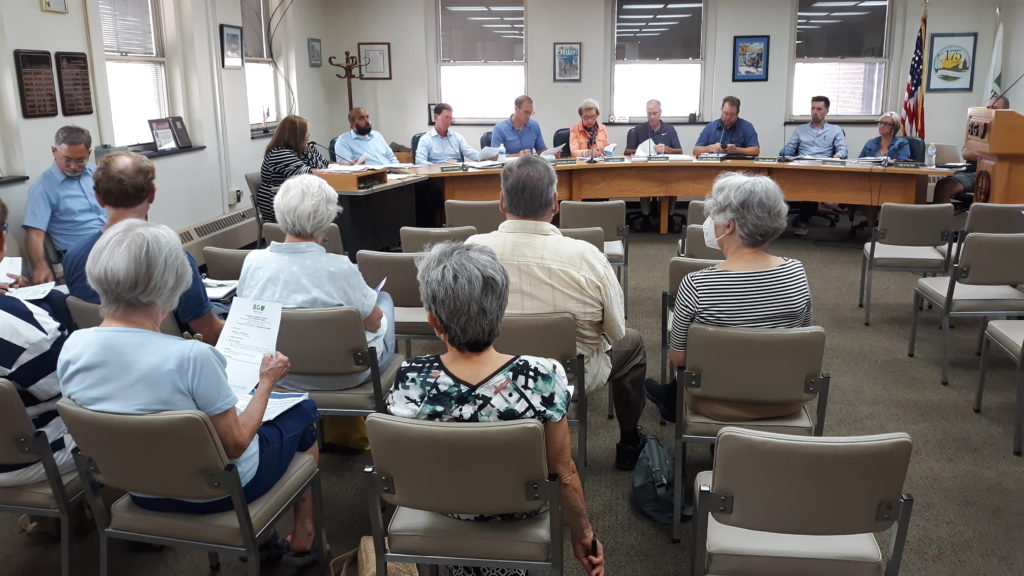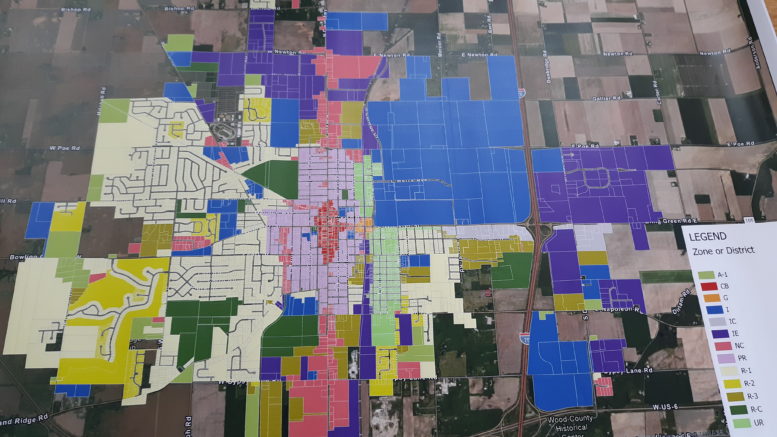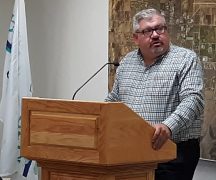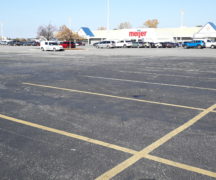By JAN LARSON McLAUGHLIN
BG Independent News
Residents protective of their homes met Wednesday evening with city leaders wanting to bring Bowling Green’s zoning code into the 21 century.
Some see the zoning update as a way to bring new life – both residential and business – into the community. But one change in particular, the addition of “pedestrian residential”
districts, has stirred ill feelings among some about the zoning update.
To some, the change brings visions of a neighborhood bookstore, coffee shop or little grocery nestled in amongst homes.
But others envision the zoning change as letting more nuisances and disruptions in their neighborhoods, leading to lower home values.
Planning Commission President Bob McOmber started by setting the ground rules for the meeting.
First, he stressed that the zoning code update is not a done deal. “That is definitely not the case.”
Second, there is no hidden agenda. “The agenda is to end up with a better zoning code than we have now,” he said. The current cumbersome zoning code is more than 50 years old.
Next, the planning commission will make a recommendation to City Council – which will make its own revisions before adopting the update.
“This is not just a rubber stamp kind of situation,” McOmber said.
Also, citizen criticisms of ZoneCo, the firm hired by the city to work on the zoning code update, are unfair, he added.
“ZoneCo should not be a scapegoat in this,” McOmber said. “I think they have come up with a very reasonable proposal.”
Moreover, the concept of allowing certain small businesses in residential neighborhoods – the source of most of the citizen complaints – is not new, he said.
“Walkable neighborhoods have been talked about for a number of years,” McOmber said.
And lastly, everyone at the meeting was expected to behave.
“I will insist that everyone be courteous and respectful of everyone,” McOmber said.
Then everyone who wanted to talk about the zoning update – specifically the new “pedestrian residential” category – was allowed time to speak. Though the PR category stretches a few blocks on each side of Main Street from Poe Road to Napoleon Road, the eight residents who spoke all lived in the area of Buttonwood, South Grove, Eberly, South Maple and West Wooster streets.
Many have lived in their homes for decades, and appreciate the old architecture and quiet of their neighborhood.
Fern Larking Kao asked how many of the planning, zoning and council members lived in the areas proposed as pedestrian residential. Three of the nine planning commission members raised their hands. Two of the five zoning board members do, as well as two City Council members.
Linda Duda voiced concerns about the reduced front yard setbacks, which would expose homes to the increased glare of the city’s new LED streetlights. Duda shared concerns about home values, and asked if the zoning update’s goal was to tear down old houses in the pedestrian residential districts and put up new houses.
McOmber assured her that was not the case.
“I don’t think that’s up for even discussion,” he said.
“I don’t think any of us want to tear down buildings or not grandfather buildings,” said planning commission member Judy Ennis.

Peg Baker asked why the neighborhoods extending on both sides of Main Street are being considered for “pedestrian residential.” She suggested that a more appropriate place might be at the mall on North Main Street, where homes could be built close to the businesses there – “rather than tear apart the neighborhoods we have.”
Ken Parker objected to the new zoning which would encourage businesses to be “sprinkled in” with housing. He said the “peaceful tranquility at my home is non-existent” since the opening of a brewery in his neighborhood.
Emily Dunipace said there is no need to add businesses to the neighborhoods to make them walkable.
“I would argue with you that we already have a walkable Bowling Green,” she said.
Dunipace also asked about the pedestrian residential zoning being thrust on neighborhoods that already have a higher rate of rental houses, which she considers businesses.
“How much more burden are we asking homeowners to bear,” she said. She asked about the impact of more businesses mixed with homes. “Does that really make a better neighborhood?”
Dunipace also asked about home values. “Who’s going to pay top dollar for a home next to a bar?”
Planning commission member Mark Remeis, who works in real estate, shared his perspective on the matter.
“Homes are not automatically devalued when you sprinkle in businesses,” he said. “People in this room would be surprised.”
Jim Evans said he had some concerns when reading the zoning proposal, such as the reduced front yard setback and the increased residential density. He agreed that he didn’t want homes “shoehorned” into small lots.
However, Evans said a lot of the concerns about the zoning update could be alleviated by the addition of language stating that all legal and conformable properties will continue to be legal and conformable under the new zoning.
David Wilson, of Eberly Avenue, repeated his concerns that he had voiced to City Council on Tuesday evening. He again objected to the plan of embedding businesses within his residential area.
“This matter is dividing the neighbors and neighborhood,” he said. “The end result will be to either accept the forced social experiment changes or exit the district or even the city.”
Wilson also repeated his accusations that city officials already have their minds made up about the proposed zoning update.
“We obviously have no real say in this matter or decision. Sure, you the city will politely listen to our comments and concerns, and then do what you have planned, thus forcing us to take legal steps to bring it to the public’s attention to stop it.”
Remeis assured residents that they were being heard.
There should be “no preconceived notion that this is a done deal,” he said.
But Remeis also stressed that this is Bowling Green’s chance to bring life – residential and business – to the community.
“I personally feel this is our city’s opportunity to enact some positive changes,” he said, adding that he understood people would be impacted. “I hope that we can be open to some change. It doesn’t always have to be bad.”
Remeis said the current zoning is limiting to business – and has led to the loss of some prospects.
“We have a finite area where they can locate,” he said. “We have lost businesses in the last 10 years because of the restrictions that sit here today.”
Changes could also attract younger residents, Remeis said.
“That might make individuals want to move back to Bowling Green, or stay in Bowling Green when they graduate from BGSU,” he said.
Planning commission member Tom Stalter agreed.
“This zoning code is way overdue,” he said. “The city needs something to make it more vibrant.”
But some planning commission members wanted proof that the zoning changes would actually do what they are intended to do. Abhishek Bhati asked for data showing that the changes would increase the availability of housing and make neighborhoods more walkable. He also said that he already finds Bowling Green to be a “walkable” community.
Bhati said he wasn’t convinced that the zoning category would create healthy neighborhoods where people want to live.
Nolan Nicaise, urban and environmental planner at ZoneCo, also offered a different perspective, stressing that it is extremely difficult for young people to get into the housing market. By making way for smaller, divided homes, Bowling Green could be accessible to them.
“You are allowing them to stay in a community they want to stay in,” he said.
Nicaise also emphasized that renters are members of the community. “You are still someone who is shopping and spending money.”
Also during the meeting, the planning commission debated the finer details of which businesses may be allowed in pedestrian residential areas. For example, restaurants would be a “conditional” use.
“We want to avoid the Applebees, but we want to invite the small cafe,” Will Airhart said.
The commission set its next meeting for Monday, July 11, at 7 p.m. Among the items to be discussed will be the setting of rules for businesses in pedestrian residential areas. Those rules would cover such issues as traffic, outdoor noises, hours of operation, parking and density.
To view the proposed zoning code update:
- Go to www.bgohio.org
- Go to “departments” at the top of the page.
- Go to “planning department.”
- Then go to “zoning code update” (toward the bottom since the list is in alphabetical order.)





